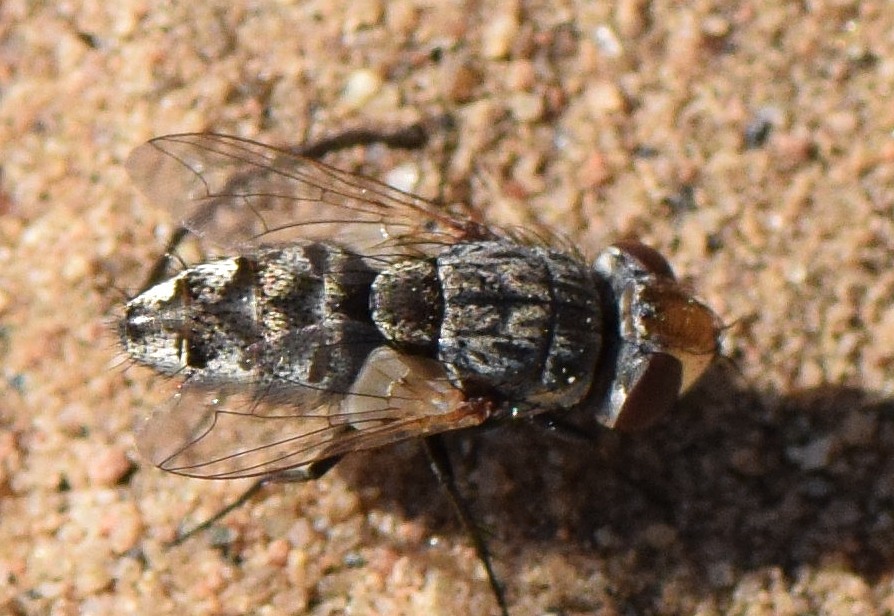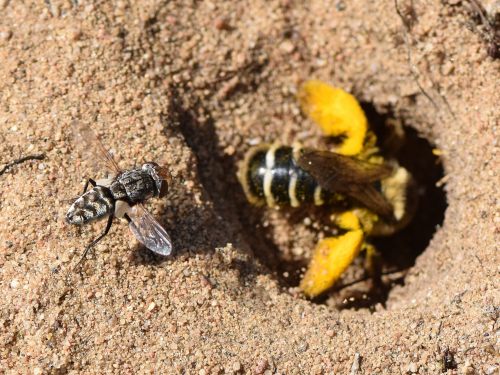Diptera.info :: Identification queries :: Diptera (adults)
|
Miltogramma on Dasypoda?
|
|
| ebbek |
Posted on 10-08-2022 15:00
|
|
Member Location: SW Sweden, Halland Posts: 1447 Joined: 23.06.08 |
Today i watched a Miltogramma that was very interested in a nest with i digging solitary bee (Dasypoda hirtipes). I think it is Miltogramma oestraceum and is iot possible to confirm? From SW Sweden today. Regards Krister ebbek attached the following image:  [231.38Kb] Edited by ebbek on 10-08-2022 15:03 |
|
|
|
| ebbek |
Posted on 10-08-2022 15:09
|
|
Member Location: SW Sweden, Halland Posts: 1447 Joined: 23.06.08 |
Another view
ebbek attached the following image:  [85.55Kb] Edited by ebbek on 10-08-2022 15:12 |
|
|
|
| ebbek |
Posted on 10-08-2022 15:09
|
|
Member Location: SW Sweden, Halland Posts: 1447 Joined: 23.06.08 |
Another view
ebbek attached the following image:  [85.55Kb] Edited by ebbek on 10-08-2022 15:12 |
|
|
|
| Sundew |
Posted on 10-08-2022 15:29
|
|
Member Location: Berlin and Baden-Württemberg, Germany Posts: 3938 Joined: 28.07.07 |
M. oestraceum seems to be the only brood parasite of Dasypoda hirtipes (https://www.wildb...i-p842.htm); it puts its eggs to the pollen supply of the larva. Since such interactions are highly specific, your guess should be correct! Regards, Sundew |
|
|
|
| ebbek |
Posted on 10-08-2022 15:45
|
|
Member Location: SW Sweden, Halland Posts: 1447 Joined: 23.06.08 |
Great - many thanks! Krister |
|
|
|
| Zeegers |
Posted on 11-08-2022 08:02
|
|
Member Location: Soest, NL Posts: 19213 Joined: 21.07.04 |
Well, there is a difference between “only”. and “only recorded”. Moreover, females of oestraceum cannot be separated from germari, officially. This one looks like germari to me. Theo |
|
|
|
| Sundew |
Posted on 11-08-2022 14:27
|
|
Member Location: Berlin and Baden-Württemberg, Germany Posts: 3938 Joined: 28.07.07 |
I thought Daniel Whitmore should be able to solve the problem. Here is his answer: "Many Miltogramminae aren't species-specific, so Theo is right. M. germari is a known parasite of D. hirtipes." He refers to two interesting papers by Welch & Owens (2017, 2019) found in https://ia601707....12unse.pdf and https://dipterist...No%202.pdf. So three Miltogramma species are known to be cleptoparasites of Dasypoda hirtipes, and we can only exclude M. punctata. 1:0 for Theo  ! ! |
|
|
|
| ebbek |
Posted on 04-08-2023 18:29
|
|
Member Location: SW Sweden, Halland Posts: 1447 Joined: 23.06.08 |
Thanks Theo and Sundew - very interesting info! I have missed your replies and saw them at first today. Regards Krister |
|
|
|
| Jump to Forum: |












